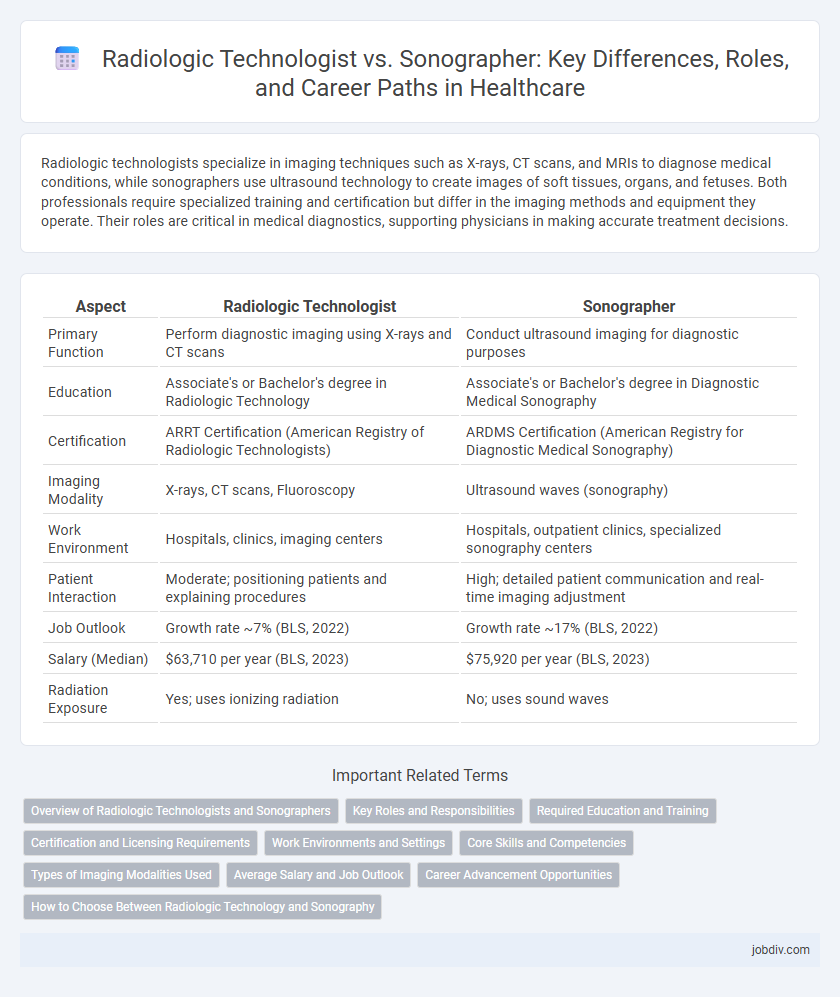Radiologic technologists specialize in imaging techniques such as X-rays, CT scans, and MRIs to diagnose medical conditions, while sonographers use ultrasound technology to create images of soft tissues, organs, and fetuses. Both professionals require specialized training and certification but differ in the imaging methods and equipment they operate. Their roles are critical in medical diagnostics, supporting physicians in making accurate treatment decisions.
Table of Comparison
| Aspect | Radiologic Technologist | Sonographer |
|---|---|---|
| Primary Function | Perform diagnostic imaging using X-rays and CT scans | Conduct ultrasound imaging for diagnostic purposes |
| Education | Associate's or Bachelor's degree in Radiologic Technology | Associate's or Bachelor's degree in Diagnostic Medical Sonography |
| Certification | ARRT Certification (American Registry of Radiologic Technologists) | ARDMS Certification (American Registry for Diagnostic Medical Sonography) |
| Imaging Modality | X-rays, CT scans, Fluoroscopy | Ultrasound waves (sonography) |
| Work Environment | Hospitals, clinics, imaging centers | Hospitals, outpatient clinics, specialized sonography centers |
| Patient Interaction | Moderate; positioning patients and explaining procedures | High; detailed patient communication and real-time imaging adjustment |
| Job Outlook | Growth rate ~7% (BLS, 2022) | Growth rate ~17% (BLS, 2022) |
| Salary (Median) | $63,710 per year (BLS, 2023) | $75,920 per year (BLS, 2023) |
| Radiation Exposure | Yes; uses ionizing radiation | No; uses sound waves |
Overview of Radiologic Technologists and Sonographers
Radiologic technologists specialize in performing diagnostic imaging procedures such as X-rays, CT scans, and MRIs, utilizing radiation to capture detailed internal body images. Sonographers use ultrasound technology to create real-time images of organs, tissues, and blood flow, primarily aiding in obstetric, cardiac, and abdominal diagnoses. Both professions require specialized training and certification to ensure accuracy and patient safety in medical imaging.
Key Roles and Responsibilities
Radiologic Technologists specialize in performing diagnostic imaging examinations such as X-rays, CT scans, and MRIs, ensuring precise image quality and patient safety during radiation exposure. Sonographers focus on using ultrasound equipment to capture real-time images of internal organs, blood flow, and fetal development, requiring expertise in anatomy and pathology interpretation. Both professionals collaborate with physicians to aid in diagnosis but differ primarily in imaging modality and patient interaction methods.
Required Education and Training
Radiologic technologists typically require an associate degree in radiologic technology and must earn certification from the American Registry of Radiologic Technologists (ARRT) to perform diagnostic imaging procedures such as X-rays. Sonographers generally need an associate or bachelor's degree in diagnostic medical sonography, with certification from the American Registry for Diagnostic Medical Sonography (ARDMS) to operate ultrasound equipment and conduct sonographic exams. Both professions demand clinical training hours and ongoing continuing education to maintain certification and comply with healthcare standards.
Certification and Licensing Requirements
Radiologic technologists must obtain certification from the American Registry of Radiologic Technologists (ARRT) and acquire state-specific licenses to perform diagnostic imaging procedures. Sonographers are typically certified by the American Registry for Diagnostic Medical Sonography (ARDMS) and must comply with varying state licensure mandates. Both professions emphasize rigorous credentialing to ensure proficiency and adherence to safety standards in patient care.
Work Environments and Settings
Radiologic technologists predominantly work in hospitals, outpatient imaging centers, and specialized diagnostic labs, utilizing X-ray, CT, and MRI equipment to capture internal images. Sonographers are commonly found in hospitals, physician offices, and prenatal clinics, specializing in ultrasound imaging to monitor pregnancies and diagnose soft tissue conditions. Both professionals frequently collaborate in medical settings but differ in the technologies and environments specific to their diagnostic roles.
Core Skills and Competencies
Radiologic technologists possess core skills in operating X-ray, CT, and MRI machines, with competencies in patient positioning, radiation safety, and image analysis. Sonographers specialize in using ultrasound equipment, demonstrating expertise in anatomy knowledge, Doppler imaging, and real-time scanning techniques. Both roles require strong patient communication, attention to detail, and proficiency in interpreting diagnostic images to assist medical professionals accurately.
Types of Imaging Modalities Used
Radiologic technologists primarily use X-rays, CT scans, and MRI to create detailed images for diagnosis, utilizing radiation-based modalities. Sonographers specialize in ultrasound imaging, employing high-frequency sound waves to visualize soft tissues, organs, and blood flow without radiation exposure. Both professionals play crucial roles in diagnostic imaging but differ in the technologies and techniques they apply to capture medical images.
Average Salary and Job Outlook
Radiologic technologists earn an average salary of approximately $63,000 per year, with job growth projected at 9% through 2031, driven by increasing demand for diagnostic imaging. Sonographers typically have a higher average salary around $75,000 annually, supported by a faster job outlook growth of 14%, reflecting the expanding use of ultrasound technology in medical diagnostics. Both professions offer strong employment potential, but sonography commands a premium due to specialized skills and broader clinical applications.
Career Advancement Opportunities
Radiologic technologists can advance their careers by specializing in areas such as MRI, CT, or interventional radiography, or by moving into roles like radiology manager or educator. Sonographers have opportunities to specialize in fields such as obstetric, abdominal, or vascular sonography, and can progress to supervisory, teaching, or healthcare administration positions. Both professions offer pathways for certification and advanced training that enhance career growth and salary potential.
How to Choose Between Radiologic Technology and Sonography
Choosing between radiologic technology and sonography depends on your interest in imaging techniques, career goals, and patient interaction. Radiologic technologists specialize in X-rays and CT scans, offering opportunities in diverse diagnostic environments with radiation exposure considerations. Sonographers use ultrasound technology for real-time imaging, often favoring patient engagement and roles in obstetrics and cardiology, with lower exposure to ionizing radiation.
Radiologic Technologist vs Sonographer Infographic

 jobdiv.com
jobdiv.com